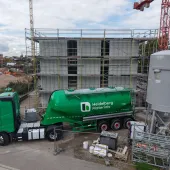UoT turn demolished concrete into sustainable building bricks
Researchers at the University of Tokyo have unveiled an exciting new method that could transform the construction industry by turning old concrete from demolished buildings into brand-new, sturdy building materials. This innovative approach not only provides a greener way to recycle waste but also helps capture carbon dioxide (CO2) from the air, marking a significant step forward for sustainable construction.
The groundbreaking technique, developed by Professors Takafumi Noguchi and Ippei Maruyama from the University's Department of Architecture, creates a new type of material called calcium carbonate concrete. The process involves grinding old concrete into a fine powder and combining it with CO2 extracted from the air or industrial exhaust. The mixture is then pressurised in layers within a mould and heated to form strong, durable bricks that could be used to construct houses and pavements.
This new method could revolutionise the way the construction industry thinks about demolition waste. Instead of viewing old, crumbling structures as useless, they could be seen as valuable 'urban mines'—sources of raw material for new construction projects. Remarkably, these new blocks can be recycled repeatedly through the same process, offering a sustainable alternative to traditional construction materials.
The development builds on previous research at the University of Tokyo, where scientists designed a new type of concrete aimed at reducing greenhouse gas emissions and reusing construction waste. Their latest breakthrough represents a major leap forward, as the new calcium carbonate concrete bricks are now large and robust enough for standard construction uses, including building homes and laying pavements.
This innovation is part of a larger initiative called the Calcium Carbonate Circulation System for Construction (C4S). The C4S project is focused on promoting a circular economy and achieving carbon neutrality by reducing the demand for new materials and maximising the reuse of existing resources. This is particularly important in countries like Japan, where limestone reserves—essential for traditional concrete—are dwindling.
“We are excited about developing systems that contribute to a circular economy and carbon neutrality,” said Professor Maruyama. “In Japan, the current demand for construction materials is less than it used to be, so it’s a perfect time to innovate with a new type of construction business. Our research helps us better understand this vital material and its potential.”
The team has already proven the viability of their method by successfully creating concrete bricks from the remains of a demolished school building. The old concrete was crushed into powder, sieved, and subjected to an accelerated carbonation process to ensure that the new bricks matched the strength of traditional concrete. They were then further reinforced by being pressurised with a calcium bicarbonate solution and heated in a mould.
Looking ahead, the researchers are enthusiastic about the future. “As part of the C4S project, we plan to build a real two-storey house by 2030,” Maruyama shared. “Over the next few years, we’re moving towards a pilot plant to improve production efficiency and scale up industrial applications. Our goal is to create much larger building elements and make this sustainable material commercially available.”
This new technology could offer an exciting opportunity for the UK’s construction sector, providing a sustainable option for future projects that reduces the carbon footprint of new builds while turning urban concrete waste into a valuable resource.







